Watch Stars Drift and Constellations Change Shape Using Mobile Apps

We assume that the stars' positions in the heavens are eternal. But everything in space is in motion. As our Milky Way rotates, our sun is carried once around the galaxy every 250 million years, slowly drifting up and down through the galaxy's disk, like a horse on a carousel. The stars in the galaxy tug on one another gravitationally, which forces them to shift around. Astronomers know of many clusters of young stars that formed together and are now migrating through the galaxy as a group. And scientists can identify individual cluster members that have been ejected due to gravitational forces exerted by surrounding stars.
For the most part, the motions of stars are not obvious over the course of human life spans. However, the constellations formed by stars have altered in appearance over recorded history. Additionally, several stars located close to our sun noticeably change their location from one year to the next, and skywatchers with backyard telescopes can watch the progress of these stars.
In this edition of Mobile Astronomy, we'll focus on wandering stars. We'll highlight some fast-moving ones and tell you how to see them using your favorite astronomy app. And we will tell you how to re-create what our modern-day constellations looked like when humankind first saw pictures in the stars, as well as what our descendants will see in the distant future. [Orion Transformed: Familiar Constellation Will Shift Over Millennia (Video)]
Stellar motion 101
Because stars can move in any direction in space, they can travel laterally (sideways), radially (towards or away from our solar system), or a combination of both those types of motion. Lateral motions change stars' coordinates on the sky, gradually rearranging our star maps. Astronomers can also measure the Doppler shifts of a star's spectrum to determine whether a star is approaching or receding from our solar system, but such radial motion won't alter a star's position in our sky.
Astronomers use the term "proper motion" to describe the change in position of a star over time as viewed from our solar system; they also use the term "apparent motion." That perceived movement actually consists of a blend of a star's inherent motion through the galaxy plus the change in our sun's position over the same period. (We will ignore the changes caused by parallax as Earth orbits the sun, because those average out over the year.)
Proper motion tends to be very small for distant stars and large for closer stars, although even nearby stars can have a proper-motion value of zero if they aren't moving sideways.
Before computing machines became available, astronomers carefully measured the declination and right-ascension coordinates of stars, wrote these values down in star catalogs, and hand-plotted the stars on sky charts. (R.A. and Dec. on the celestial sphere, to use the measures' abbreviations, are analogous to longitude and latitude, respectively, on the Earth's globe.)
Get the Space.com Newsletter
Breaking space news, the latest updates on rocket launches, skywatching events and more!
As instrumentation improved, astronomers found that some stars were changing their positions over time, so catalogs and charts had to be regularly updated and reissued — generally every five years. Eventually, star catalogs included the rate and direction that the stars moved. Nowadays, online digital star catalogs are hosted and updated by the U.S. Naval Observatory and other public organizations. Mobile astronomy apps and desktop planetarium software regularly download those catalogs and use the data to display each star in its correct position on any given date.
To chart stellar motion even more accurately, researchers have sent multiple missions into space. The Hipparcos spacecraft set out to accurately measure star positions to help scientists learn more about the galaxy. A follow-up mission named Gaia is currently measuring a billion stars to high accuracy. That information will soon inform astronomy apps. And not only will the information help make our night-sky models more accurate, but astronomers can also use stellar motion to study how the galaxy is structured and evolving. [This 3D Color Map of 1.7 Billion Stars in the Milky Way Is the Best Ever]
Seeing constellations change over time
Many of our 88 modern constellations have their origins in Babylonian astronomy. Around 1370 B.C., those ancient astronomers took note of the relationship between the seasons and the stars and created the earliest known star catalogs: the Three Stars Each list and the Mul.Apin, both of which survive as stone tablets. That knowledge was later passed on to the ancient Greeks, who laid the foundations of modern Western astronomy. The modern zodiac constellations — including Taurus, the bull; Leo, the lion; and Scorpius, the scorpion — first appeared in those ancient texts.
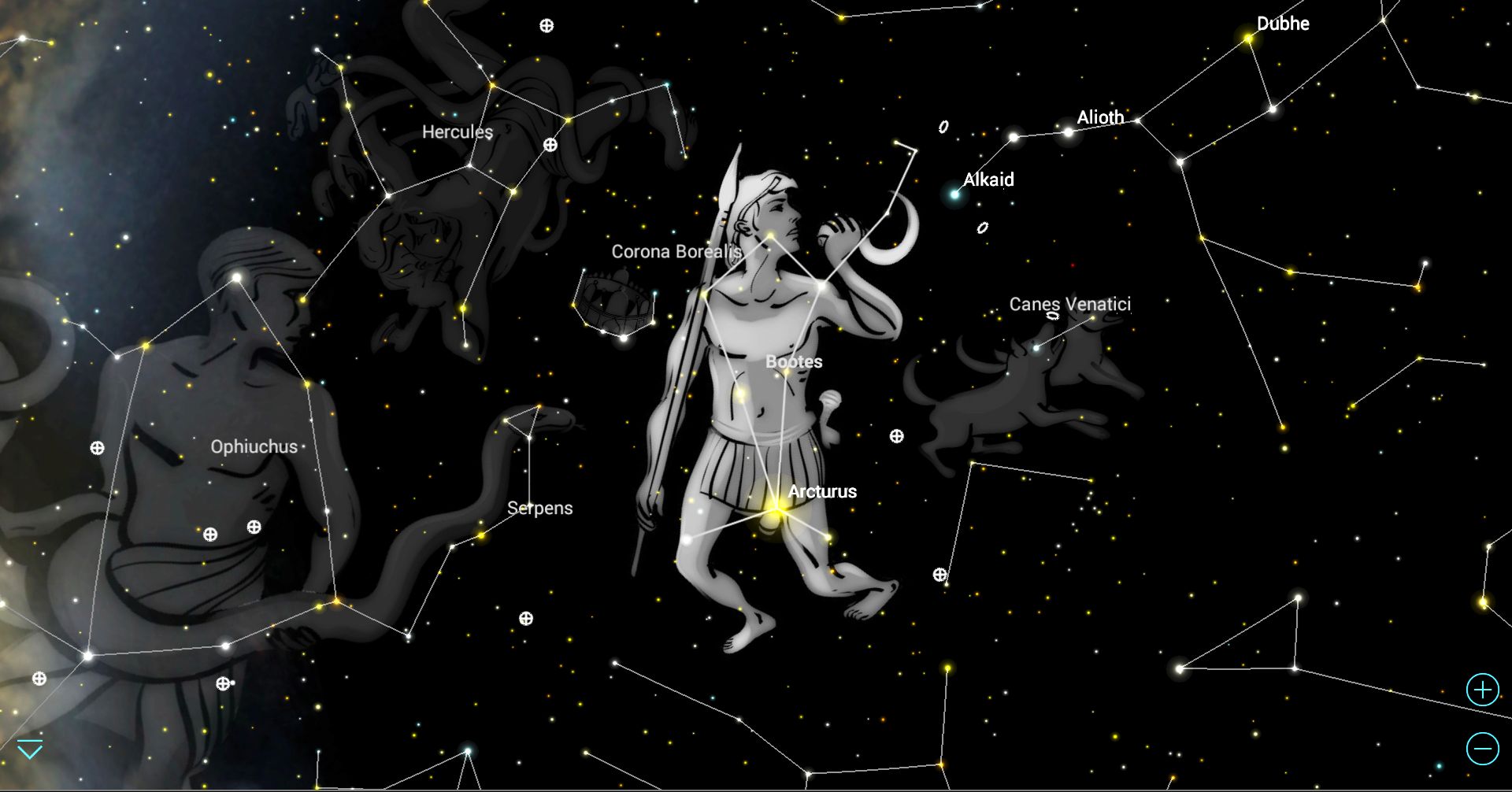
Due to the action of stellar proper motion over millennia, the constellations we see today are altered from the star patterns that the Babylonians saw. In most cases, the changes are barely noticeable, but a few are readily apparent. Advanced astronomy apps such as SkySafari 6, Stellarium Mobile, and Star Walk 2 allow you to view the sky in different eras, so you can travel back in time to see the ancient sky and preview the skies our descendents will enjoy in the far future.
Some apps require you to manually enter the year that you'd like to see or scroll through the years sequentially. With SkySafari 6, you can easily jump through time. In this app, open the Settings menu. Under the Precession item, enable the Proper Motion option. (This change can be permanent. It won't affect your regular use of the app.) Under Coordinates, switch to Ecliptic. Under Horizon and Sky, disable Daylight and Horizon Glow and then disable "Show horizon and sky." For this demonstration, I also like to hide the planets. Make sure that the constellations' lines are displayed. Star names are optional.
Upon exiting the Settings menu, your app's display will show a dark sky, without any obscuring horizon, regardless of the time of day. Search and select a constellation. Ursa Major is a good choice, because everyone is familiar with this constellation's Big Dipper asterism. Use the Center icon to hold Ursa Major in place, and then open the time-flow controls.
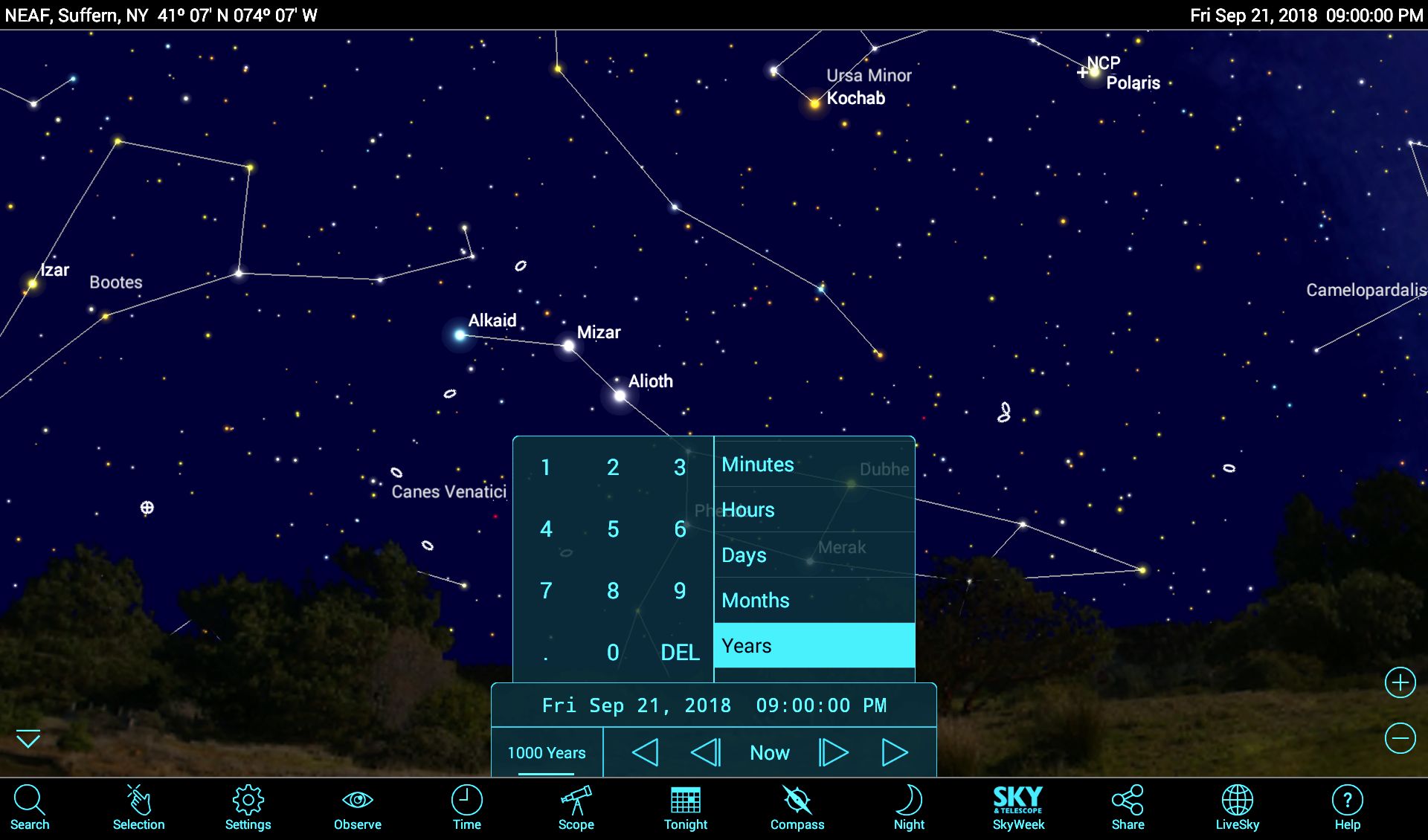
Tap the currently displayed year value. Below the label for day of the week, a box will display, "1 Year." Tap that box to open a key pad and input a large number, say 500 or 1,000. (Use the DEL key to delete the default "1" before typing in your value.) When finished, tap the same box to close the key pad. Now, every time you increment the year, it will jump by the amount you entered, i.e., 500 years. (The same increment will apply if you switch to days, hours, minutes, etc.)
With Ursa Major centered, allow time to flow forward or backward. The constellation will distort as the stars move through the galaxy. Set the year to 1480 B.C. to show the constellation as the ancient Babylonians saw it. Or go far into the future to see how our descendants will see the sky. Type the Now button to return to the current day. (In SkySafari 6, you can directly enter a specific year in the Date & Time settings menu.)

While the app is configured this way, you can check out other examples of rapidly evolving constellations. Altair in Aquila, the eagle, and Arcturus in Boötes, the herdsman, are two bright, naked-eye stars that have relatively high proper-motion values (0.66 and 2.28 arc seconds per year, respectively). Two dimmer stars, named Tarazed and Alshain, flank Altair. In the modern sky, these stars form a bent line, with Altair in the middle — as if those flanking stars are the eagle's "ears." A thousand years ago, Altair sat directly between them, and in Babylonian times, Altair was "below" them, making the two flanking stars seem more like "antennae."
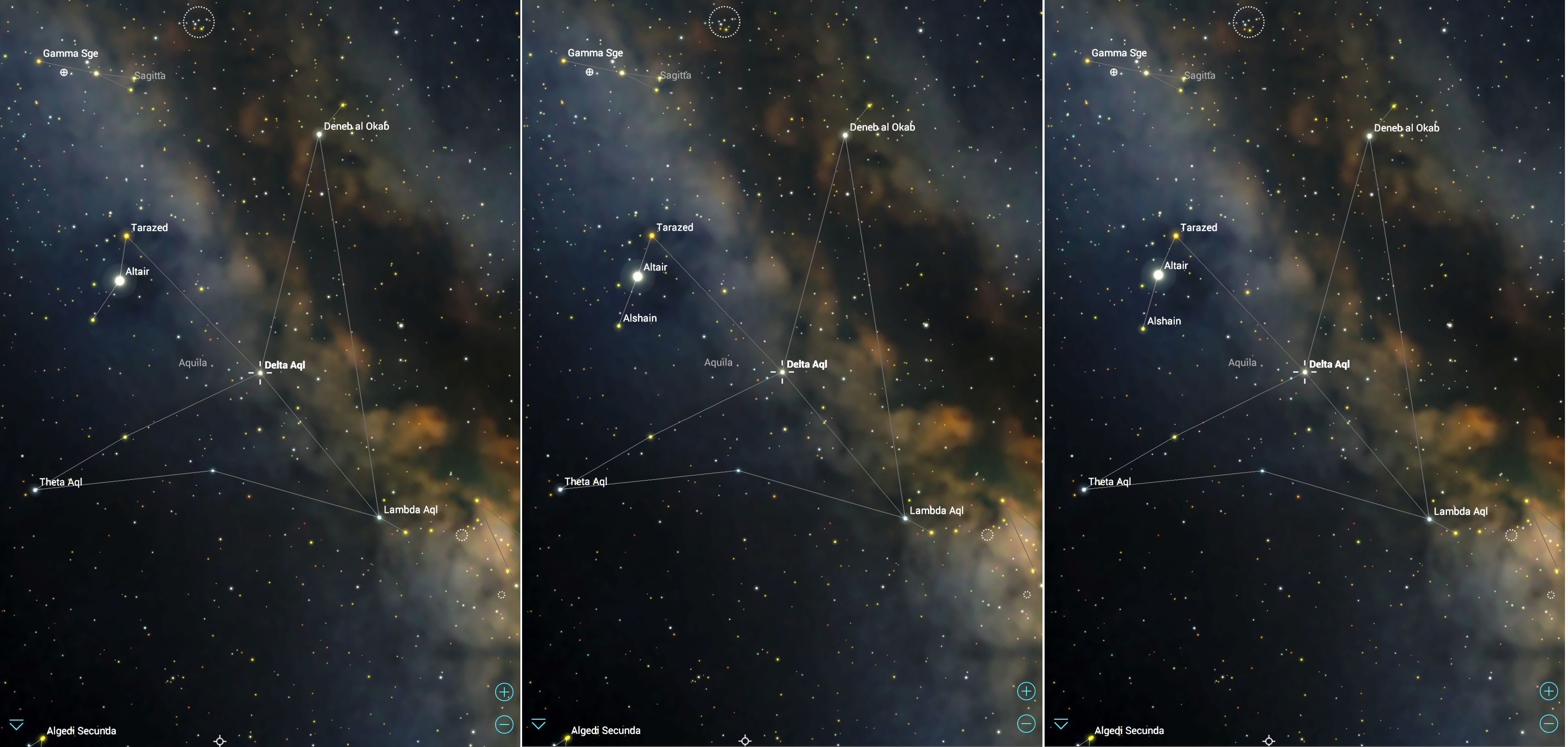
Arcturus is the very bright, orange star that sits at the base of the kite-shaped constellation Boötes. It's in the western early evening sky during September. The stars Zeta Boötes and Muphrid sit southeast and southwest of Arcturus, respectively, forming the herdsman's stubby legs. Arcturus is moving southward. Two millennia ago, it was much farther from those stars, and 3,000 years from now, Arcturus will sit between them — as if he's performing the splits!
Barnard's Star
We can use astronomy apps to see how stars with very high proper motion change their positions year over year. For example, look to the red dwarf Barnard's Star, located only 6 light-years from the sun. The star takes its name from U.S. astronomer E.E. Barnard who, in 1919, determined that this star's motion across the sky is 10.3 arc seconds per year — the largest proper motion of any star relative to the sun. (A full moon is 1,800 arc seconds across.)
Barnard's Star is located in the constellation Ophiuchus, which can be found in the southwestern sky during September evenings. At a visual magnitude of +9.53, the star is near the limit of visibility using 10 x 50 binoculars, but a backyard telescope can reveal this star to you. Your astronomy app will readily show the rapid motion of Barnard's Star across the sky.
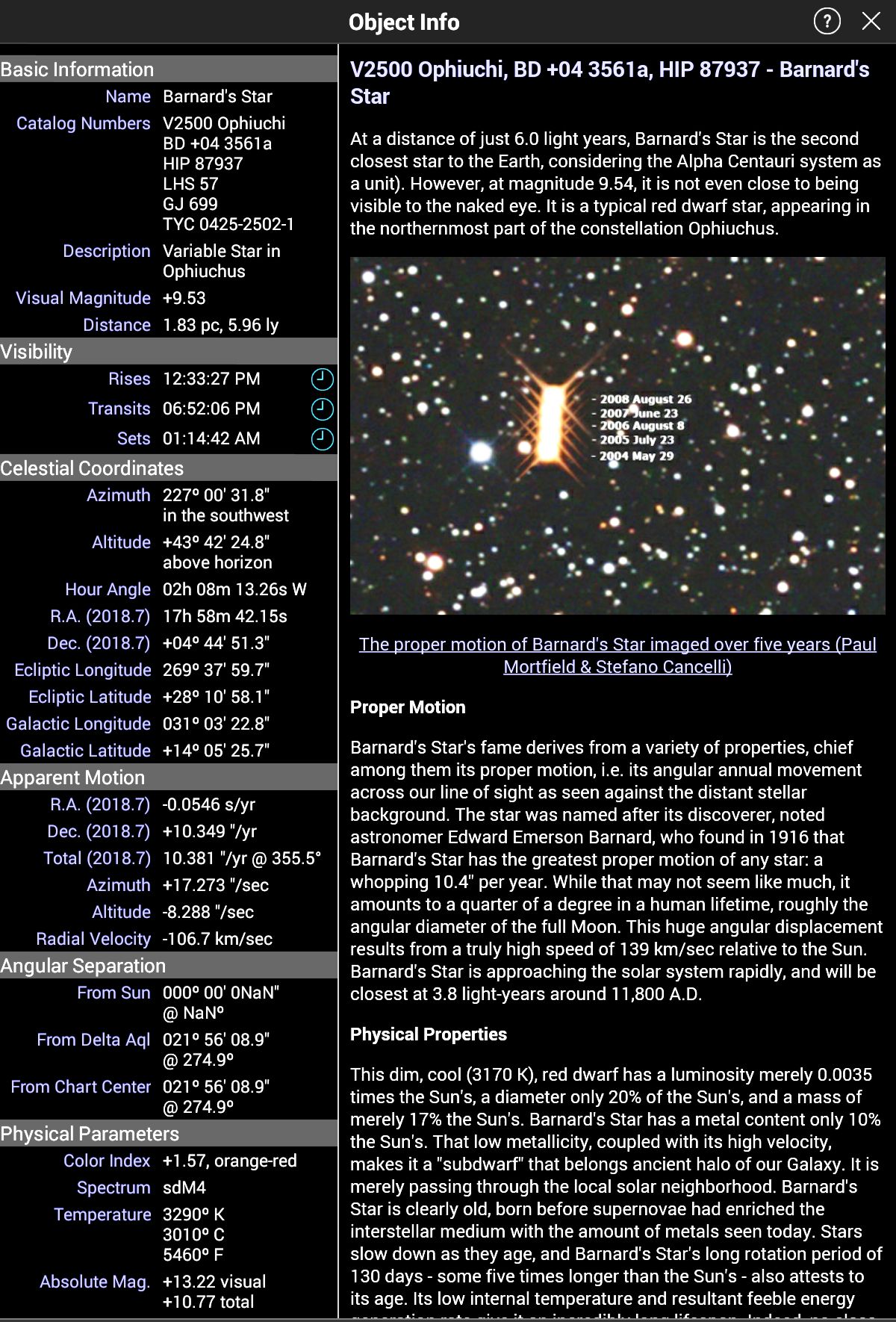
Set your app's time to about 9 p.m. local time. Use the Search menu to find Barnard's Star (other catalog names for it include V2500 Ophiuchi and HIP87937), and then use the Center icon to put the star in the middle of the app's display. Zoom in until the nearby bright star 66 Ophiuchi (or 66 Oph) is visible near the edge of the display.
Open the time controls and tap the year to select that unit as the time increment. Now, when you press the arrow icons, time will flow forward or backyard one year at a time. Every year in the future, Barnard's star shifts toward the upper right, away from 66 Oph. When the astronomer Barnard measured his star in 1919, it was positioned to the lower right of 66 Oph.
To track the motion of Barnard's Star yourself, try to find it in your telescope (a GoTo system will help) and sketch the star field around it. Every year or so, take another look and sketch the star field again. Eventually, its path will become apparent. Astrophotographers can image the star field and create a multiyear composite to show the star's motion.
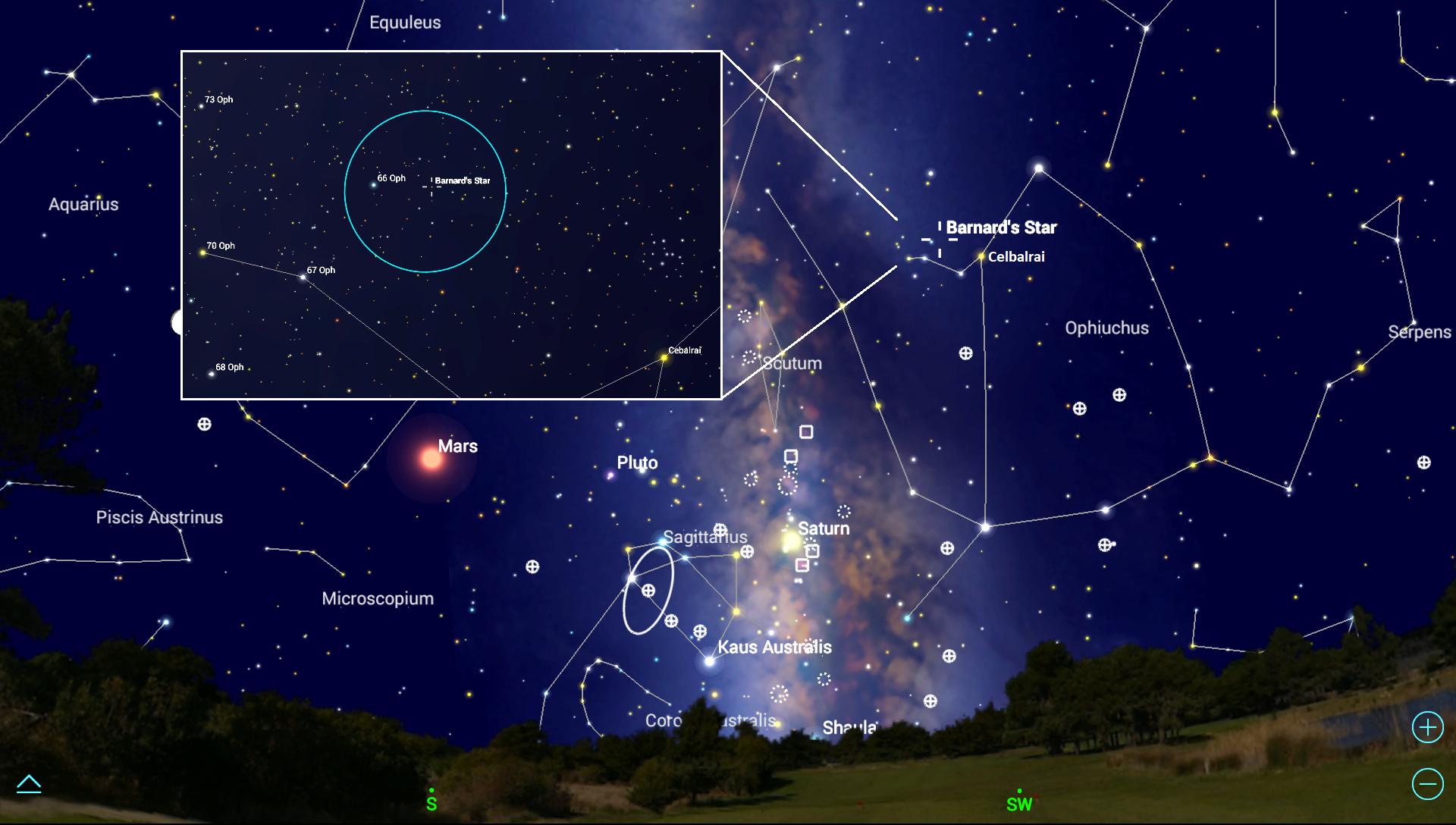
You can also test out your app on some other rapidly moving stars, including 61 Cygni in Cygnus and Groombridge 1830 and Lalande 21185, both in Ursa Major. (At this point in the year, use 5 a.m. local time, when these stars are well-placed in the sky.)
In upcoming editions of Mobile Astronomy, we'll highlight some autumn stargazing targets, discuss how to use mobile apps to plan and log your astronomical observations, and more. Until then, keep looking up!
Editor's note: Chris Vaughan is an astronomy public outreach and education specialist at AstroGeo, a member of the Royal Astronomical Society of Canada, and an operator of the historic 74-inch (1.88 meters) David Dunlap Observatory telescope. You can reach him via email, and follow him on Twitter @astrogeoguy, as well as on Facebook and Tumblr.
This article was provided by Simulation Curriculum, the leader in space science curriculum solutions and the makers of the SkySafari app for Android and iOS. Follow SkySafari on Twitter @SkySafariAstro. Follow us @Spacedotcom, Facebook and Google+. Original article on Space.com.
Join our Space Forums to keep talking space on the latest missions, night sky and more! And if you have a news tip, correction or comment, let us know at: community@space.com.
Chris Vaughan, aka @astrogeoguy, is an award-winning astronomer and Earth scientist with Astrogeo.ca, based near Toronto, Canada. He is a member of the Royal Astronomical Society of Canada and hosts their Insider's Guide to the Galaxy webcasts on YouTube. An avid visual astronomer, Chris operates the historic 74˝ telescope at the David Dunlap Observatory. He frequently organizes local star parties and solar astronomy sessions, and regularly delivers presentations about astronomy and Earth and planetary science, to students and the public in his Digital Starlab portable planetarium. His weekly Astronomy Skylights blog at www.AstroGeo.ca is enjoyed by readers worldwide. He is a regular contributor to SkyNews magazine, writes the monthly Night Sky Calendar for Space.com in cooperation with Simulation Curriculum, the creators of Starry Night and SkySafari, and content for several popular astronomy apps. His book "110 Things to See with a Telescope", was released in 2021.


